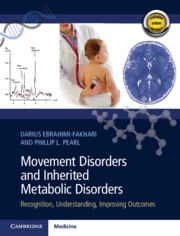Book contents
- Movement Disorders and Inherited Metabolic Disorders
- Movement Disorders and Inherited Metabolic Disorders
- Copyright page
- Dedication
- Contents
- Contributors
- Preface
- Acknowledgments
- Section I General Principles and a Phenomenology-Based Approach to Movement Disorders and Inherited Metabolic Disorders
- Chapter 1 Treatable Metabolic Movement Disorders: The Top 10
- Chapter 2 The Importance of Movement Disorders in Inborn Errors of Metabolism
- Chapter 3 The Importance of Inborn Errors of Metabolism for Movement Disorders
- Chapter 4 Imaging in Metabolic Movement Disorders
- Chapter 5 Biochemical Testing for Metabolic Movement Disorders
- Chapter 6 Genetic Testing for Metabolic Movement Disorders
- Chapter 7 A Phenomenology-Based Approach to Inborn Errors of Metabolism with Ataxia
- Chapter 8 A Phenomenology-Based Approach to Inborn Errors of Metabolism with Dystonia
- Chapter 9 A Phenomenology-Based Approach to Inborn Errors of Metabolism with Parkinsonism
- Chapter 10 A Phenomenology-Based Approach to Inborn Errors of Metabolism with Spasticity
- Chapter 11 A Phenomenology-Based Approach to Inborn Errors of Metabolism with Myoclonus
- Section II A Metabolism-Based Approach to Movement Disorders and Inherited Metabolic Disorders
- Section III Conclusions and Future Directions
- Appendix: Video Captions
- Index
- References
Chapter 7 - A Phenomenology-Based Approach to Inborn Errors of Metabolism with Ataxia
from Section I - General Principles and a Phenomenology-Based Approach to Movement Disorders and Inherited Metabolic Disorders
Published online by Cambridge University Press: 24 September 2020
- Movement Disorders and Inherited Metabolic Disorders
- Movement Disorders and Inherited Metabolic Disorders
- Copyright page
- Dedication
- Contents
- Contributors
- Preface
- Acknowledgments
- Section I General Principles and a Phenomenology-Based Approach to Movement Disorders and Inherited Metabolic Disorders
- Chapter 1 Treatable Metabolic Movement Disorders: The Top 10
- Chapter 2 The Importance of Movement Disorders in Inborn Errors of Metabolism
- Chapter 3 The Importance of Inborn Errors of Metabolism for Movement Disorders
- Chapter 4 Imaging in Metabolic Movement Disorders
- Chapter 5 Biochemical Testing for Metabolic Movement Disorders
- Chapter 6 Genetic Testing for Metabolic Movement Disorders
- Chapter 7 A Phenomenology-Based Approach to Inborn Errors of Metabolism with Ataxia
- Chapter 8 A Phenomenology-Based Approach to Inborn Errors of Metabolism with Dystonia
- Chapter 9 A Phenomenology-Based Approach to Inborn Errors of Metabolism with Parkinsonism
- Chapter 10 A Phenomenology-Based Approach to Inborn Errors of Metabolism with Spasticity
- Chapter 11 A Phenomenology-Based Approach to Inborn Errors of Metabolism with Myoclonus
- Section II A Metabolism-Based Approach to Movement Disorders and Inherited Metabolic Disorders
- Section III Conclusions and Future Directions
- Appendix: Video Captions
- Index
- References
Summary
Ataxia means “lack of order,” and is defined as a cerebellar disorder characterized by disturbances of coordinated muscle activity. Clinically, cerebellar dysfunction manifests as nystagmus, dysarthria, intention tremor, dysdiadochokinesia, dysmetria, and/or gait ataxia [1]. Ataxia can be seen in numerous genetic, degenerative, and acquired diseases. For a consistent terminology and suggested work-up in this chapter, ataxia is phenotypically classified as: intermittent ataxia, chronic (progressive) ataxia, and ataxia with myoclonic epilepsy [2]
- Type
- Chapter
- Information
- Movement Disorders and Inherited Metabolic DisordersRecognition, Understanding, Improving Outcomes, pp. 94 - 110Publisher: Cambridge University PressPrint publication year: 2020



